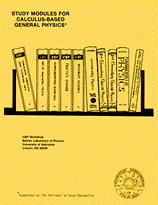Instructional Materials in Physics and Astronomy

Calculus-Based General Physics
Date of this Version
1975
Document Type
Article
Abstract
Have you ever felt you were the slave of a clock? Clocks are mechanisims that include a pendulum or balance wheel whose repeated patterns of movement define equal time intervals, one after another. Such repeated movements are called periodic motion. Periodic motion may occur when a particle or body is confined to a limited region of space by the forces acting on it and does not have sufficient energy to escape.
In this module you will study the special kind of periodic motion that results when the net force acting on a particle, often called the restoring force, is directly proportional to the particle's displacement from its equilibrium position; this is known as simple harmonic motion. Actually, simple harmonic motion is an idealization that applies only when friction, finite size, and other small effects in real physical systems are neglected. But it is a good enough approximation that it ranks in importance with other special kinds of motion (free fall, circular and rotational motion) that you have already studied. Examples of simple harmonic motion include cars without shock absorbers, a child's swing, violin strings, and, more importantly, certain electrical circuits and vibrations of a tuning fork that you may study in later modules.


Comments
From Study Modules for Calculus-Based General Physics
Copyright © 1975 CBP Workshop, University of Nebraska–Lincoln.
Reproduction rights granted.